The Choreography of Noise
Analysis of Henry Gwiazda’s “buzzingreynold’sdreamland”
The combination of sampling art and collage is a fundamental principle of the musical work of the American composer Henry Gwiazda, who calls himself a samplerist. This label stresses not only his interest in sound per se on the one hand, but his various abilities regarding the fusion of different musical contexts on the other. Spatialization further allows for the expansion and articulation of music in real space. buzzingreynold’sdreamland is a composition by Gwiazda that explores the musical capabilities of sampled sounds, experiments with the narrativity of spatialization and builds bridges to different genres of electroacoustic music, such as musique acousmatique. This paper analyzes the composition in terms of its sounds, motives and real and virtual spaces in a descriptive form, and explores its construction through the recognition of its compositional components.
http://www.henrygwiazda.com
Henry Gwiazda became interested in the collage technique in 1986 and subsequently composed a number of works that explore various combinations of different kinds of samples. In jamesbrownesque he uses samples from Papa’s Got a Brand New Bag; allamericanguitarhero incorporates samples from American guitarists; in hendrixesque he combines cello music with samples from Jimi Hendrix; sinfony includes a Cassation by Mozart; in whereMusicco-Mesfrom he uses unrecognizable orchestra music from the early 20th century; and in compositions such as IAtenightAntigone and lighTV he utilizes television advertisements and news. These samples are mixed with other sound materials and arranged in a multi-channel array to be projected through loudspeakers in a concert setting with live guitar music. Although his compositions have been called “a very modern version of musique concrète” (Wierzbicki 1992) because of their consistent use of recorded sound material, Gwiazda differs from the pioneers of electroacoustic music not only in his selection of sound material but also in his compositional processes. The only point of contact is perhaps the common interest in the objet trouvé as a non-synthetic sound. Gwiazda writes:
My compositional method here was not one of minimalism. Nor was I interested in the techniques of early concrete composers. The early electroacoustic composers generally used a small vocabulary of recorded sounds and relied on manipulation to obtain musical development and variety. Although they were working in a new medium, they were using the traditional development techniques of European music. My thought, however, was one of inclusion, rather than exclusion. I was interested in pluralism, creating a coherent musical fabric by seeking out the musical similarities in these seemingly divergent sounds and incorporating them into an artistic whole. I found that the wider my palette, the more expressive the work. (Gwiazda 1995)
James Wierzbicki compares Gwiazda with musique concrète composers and describes the differences between them as resulting from the former’s use of a polished technique in contrast to the latter’s need to overcome elementary technical problems in the 1950s:
Because the equipment was so limited, the early musique concrète pieces had to be fairly thin in texture. It was by choice, though, that most of them were dramatic in design; using one sound at a time, the composers built pieces that told non-verbal stories. In sharp contrast, Gwiazda’s music is packed almost to overflowing with sounds. They gush out from prerecorded tapes as well as from the sampler, occasionally from an electric guitar — faster than a listener can count them. Most important, they serve not as elements in a narrative but as mere droplets in a veritable shower of fleeting images. (Wierzbicki 1992)
Daniel Buckley considers Gwiazda’s music as a series of sonic images, describing the pieces as mentally cinematic works and designating these images as “musique concrète collages merging the physical and musical worlds, in the process rendering unique perspectives on both” (Buckley 1997, 203). In this way, Buckley comes close to the view of the acousmatic composers, in which the sound images are used to trigger fantasies and develop metaphors. Kyle Gann further differentiates Gwiazda from other composers of the 80s by his compositional method:
He doesn’t just offer a sound picture of the world (a superficial notion that impressed a lot of superficial people in the 80s), but creates a fantasy from the familiar, like a good novelist. He doesn’t throw noises together randomly because that’s the way life is (it isn’t), but associates them in surprising, carefully weighed combinations that shoot images into your brain. He uses bits of reality, but the way he puts them together is pure art. (Gann 1992)
Composition with sampled musical quotations and/or objets trouvés from very different sources, or of diverse sound and recording quality, carries certain risks, the most significant of which is the discontinuity of musical events. Although not a major concern in recent years owing to computer technology and the sound editing processes innovated by composers of musique concrète and electronic and tape music, the transition from one sample to another can sound quite jarring, depending on the character of the samples. This does not seem to be a disruptive factor in Gwiazda’s compositions, however. On the contrary, he looks for continuity in discontinuity and regards the successive and abrupt cuts in the sound as a new music language, comparable in its richness and capabilities to traditional music:
… the result was a collage-like texture of juxtaposition and discontinuity. I say collage-like because while historically, collage is usually static and devoid of convincing development and forward motion, these were exactly the traits I wanted my music to have. By paying close attention to the pitch and rhythmic characteristic of each sound, I wanted to go beyond collage and montage, to find a continuity and progress in discontinuity. (Gwiazda 1995)
Gwiazda first began in 1989 to use everyday noises in music: the sounds of babies, Kung Fu, percussion, an electric guitar, a harp and water in keEpingtHechildaLive; nature and crowd sounds in thEothErwildErnEss; tool noises in afterglow; urban and rural environment sounds in wHereYoulive; the combination of string sounds and animal and transportation noise in MANEATINGCHIPS LISTENINGTOAVIOLIN; and composed music for cello together with sport noises in themythofAcceptAnce. Categories of sounds and motives are built up in an exposition and are then continually processed over the course of the composition:
The structure of these works was similar. I usually began by introducing all of the “categories” of sounds that would be developed in the work. Each category (animal, instrument, transportation), would be represented by a sound (a dog bark, an organ, an engine start). These sounds would be combined and juxtaposed in the introduction. The remainder of the work consisted of sections which were devoted to each sound category. In each section, the sound category was expanded and developed. (Gwiazda 1995)
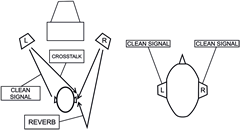
Gwiazda’s significance for the present article lies, however, not in his artistic contribution of raising the collage technique to an æsthetic concept, but in his efforts as a composer to create a three-dimensional identity for sampled musical materials. Experiments with sound categories and the processes to which they were subjected opened new doors for the composer as he discovered, like many others, a new spatial dimension of music. Successful results from new research in virtual reality led the composer to apply this technology to his musical practice in the early 90s:
I wanted the sounds to have movement, and the space to extend out of the speakers into the audience. I first tried various speaker placements, multiple speakers and a higher volume. But this was not the effect I was looking for. In 1992, I discovered virtual audio, or 3D sound. (Gwiazda 1995)
Gwiazda’s need for an audio software package allowing for the spatial positioning of sounds in real space is satisfied by Focal Point. This software was developed in the late 80s in the USA by Bo Gehring, Les R. Titze and Garry D. Titze and was used for the first time in a disco (see sidebar). Focal Point partially addressed the enormous computational requirements of spatial audio processing. The program relies on the convolution technique, with which a mono signal can be converted into a stereo signal positionable in a three-dimensional space. Convolution is now a fundamental technology in digital signal processing, and is based on the reaction of a system to an impulse. The output signal is a combination of the input signal and temporally-shifted, scaled impulse responses of the system. As a result, any signal can be regarded as a virtual impulse response of a virtual system and represent a real or an imaginary space, which in turn makes it possible to imagine and simulate any real or imaginary space in terms of an audible space. Focal Point uses the convolution technique in order to produce a signal for each ear based on the digital input signal and given transfer functions. The result is a stereo signal, which with headphones, or less effectively with two loudspeakers, gives the listener the impression of hearing sounds from different positions in a real space. If the signal moves in the space, the transfer functions will be interpolated “on the fly.”
Focal Point is based on the assumption of the isolation of the signals of each audio channel, as with headphones. In order to produce spatiality, an independent signal is needed for each ear. It is possible to compare this isolation with similar visual technology, such as the isolation of rays of light by Polaroid eyeglasses for the production of three-dimensional images. Focal Point’s output can also be used on loudspeakers, however with less effectiveness because of the lack of total isolation between channels.
Gwiazda uses the program to compose for both headphones and loudspeakers. The works thefLuteintheworLdthefLuteistheworld (1995) and buzzingreynold’sdreamland (1994) are exemplary compositions for headphones and loudspeakers, respectively, that highlight the strengths and weaknesses of each medium. If the isolation of the audio channels is considered to be total, thus resulting in binaural listening, the sound localization in front of and behind the listener is not as clear as with loudspeakers. Conversely, the lack of total isolation results in imprecise impressions above and below the ear level.
buzzingreynold’sdreamland
Written in 1994, buzzingreynold’sdreamland marks an important point, if not a culmination, in Henry Gwiazda’s musical œuvre. The composition is an excellent attempt towards the projection of music in three-dimensional space with only two loudspeakers, a goal in place since the birth of electroacoustic music. It must be stressed that this work does not solve all the technical problems of such projection, but only tries to come one step closer to this goal. Thus the work should be regarded as a primarily æsthetic, rather than technical, contribution. The title buzzingreynold’sdreamland is a compound word that refers to:
… the visionary turn-of-the-century park Dreamland on Coney Island that was a cross between an amusement park, theme park and early non-computer virtual reality experience. … At night, Dreamland’s all white structures were lit up dramatically by thousands of light bulbs, creating a beautiful fantasy world in stark contrast to today’s garish theme parks. [Founder William H.] Reynold’s decision to make Dreamland into an adventure into other worlds and cultures was a departure from the other “attractions” on Coney Island. For me, it’s a fitting metaphor for the æsthetic crossroads virtual worlds face today. (Gwiazda 1995)
As mentioned above, the software and hardware of Gehring’s Focal Point corresponded to the requirements of Gwiazda’s spatial ideas. The version used by Gwiazda was released in approximately 1990 and, to my knowledge, buzzingreynold’sdreamland is the first use of this program in an electroacoustic composition. Although newer versions offer more sophisticated possibilities to the user, according to Gehring, Gwiazda is still able to accomplish effective spatialization by means of only two loudspeakers with this early software:
In buzzingreynold’sdreamland I used Focal Point 3D Audio created by Bo Gehring. With Focal Point I am able to move the sound in a space using only two speakers. By moving the mouse I can make a sound ascend, descend, and seem to emanate from somewhere other than the two speakers (spatial location). I can create geometric and non-geometric shapes that can be perceived by the listener. If I angle the speakers so that they are pointing inward, the illusion of a sound reaching out or coming toward the listener is possible. Sounds can occur above the speakers and listener up to six feet. At times, with particular sounds, I am able to place sounds to the extreme sides as well as behind the audience. With a multitrack tape recorder, I am able to move or spatially locate four sounds at a time (each spatialized sound comes out of the computer as a stereo signal; therefore, four sounds would take eight tracks). [Gwiazda 1995]
What Gwiazda accomplishes in buzzingreynold’sdreamland can be summarized as the creation of a spatially expanded holographic sound texture or holophony, a term coined by Maurice Jessel. This is done by isolating musical events, spatializing them with computer-assisted processing techniques and finally merging the output signals into two channels:
In buzzingreynold’sdreamland I was attempting to give the sound effects that are my musical language a three-dimensional life. The area in front and around the listener is a space where these sounds are placed and create shapes. My goal was to compose another physical world for the listener and inhabit it with artistic sound objects that interrelate. (Gwiazda 1995)
Holophony embeds the sounds in a three-dimensional coordinate system with the listener in the centre. And while Gwiazda’s holophony and holography evoke similar ideas, they are distinct in important ways. Apart from the fact that the technology of holography developed by Dennis Gabor in 1948 differs substantially from the technology of overlapping sounds by computer programs, the main dissimilarity lies in the fact that with holography, observers can see different sides of an object from different angles. In holophony, the spatial impression is totally destroyed with a change of hearing position. The same thing can happen even with changing the distance from the loudspeaker to the listener. While with holography different distances allow different perspectives, deviations from the best listening spot can be completely destructive for holophony.
The listening position is extremely important for buzzingreynold’sdreamland and as such is explicitly directed by the composer. Gwiazda states that while it is possible to experience the work listening on headphones:
[A]lthough you’ll hear 3D sounds, it’ll not be the effect I intended. This work is for speakers alone. Situate your speakers as far as possible. 14 feet is ideal. Elevate and position them so that the speaker cones are even with your chest when you’re seated and pointing towards you. Make sure that you have at least 4 feet from the top of the speakers to the ceiling. You should sit in front of your speakers about 10 feet and in the center. Once seated in the center move your chair backward and forward to find the sweet spot. (Gwiazda 1996)
There would seem to be a consensus that the continuous increase of audio channels and number of loudspeakers in recent decades represents a more sophisticated technique and a more flexible choice of listening position; binaural production bucks this trend. The stereo technique in buzzingreynold’sdreamland is simply an extension of binaural listening into real space using Focal Point, software that was originally developed for binaural production. And although the decrease of the number of loudspeakers and audio channels is considered a major innovation in the projection of spatial music, at the same time it has a significant disadvantage, in that the spatial structures of the music are perceptible only by one or at most two listeners per performance:
Although the aural effect is quite extraordinary, the maximum listening location, i.e. sweet spot, is very small, perhaps 3ft. by 3ft. If one moves outside this zone the spatial relationships and locations become indistinct. Therefore, the ideal audience at one time is two people. When I realized this I naturally wondered whether this restriction was feasible. How could I present this work? This is a production challenge that virtual audio shares with virtual reality; an experience that is currently, and perhaps always will be, primarily a solo human event. (Gwiazda 1995)
Critiques about the weakly social performance practice of loudspeaker music have been quite persistent, leading composers and interpreters to continually try to engage more listeners into their concerts. However, the extreme case of buzzingreynold’sdreamland, with only or two listeners per performance, seems not to have worried Gwiazda. He stresses that “people look at paintings alone, they read poetry alone, but everybody thinks music has to be a collective experience. People are going to listen to this piece alone” (Gann 1995). Kyle Gann describes his experience when listening to this work as follows:
… the piece carries a severe limitation: it can only be heard by one person at a time. The speaker alignment is calculated down to the millimeter, and the audience member sits in a chair whose mandated position is marked on the floor with tape. The spatial illusions are exactly dependent on your ears being the right distance from the speakers. Swing your head around, as I did to experiment during my second and third hearings, and the whole sonic plane shifts and distorts. From just three feet off center, it’s like looking at a painting from a 10-degree angle to the surface. (Gann 1995)
Section-by-Section Analysis
The composition is about nine minutes long and is divisible into six sections: a relatively long exposition, in which the sound categories and the main motives are introduced, three main sections connected by a transition and a concluding coda.
|
Timings |
Durations |
Form Parts |
Type of Space |
Section 1 |
0:03–2:47 |
2:44 |
Exposition |
holophonic |
Section 2 |
2:47–4:25 |
1:38 |
Main Part |
contrapuntal |
Section 3 |
4:25–5:22 |
0:57 |
Transition |
harmonic |
Section 4 |
5:22–6:01 |
0:39 |
Main Part |
contrapuntal |
Section 5 |
6:01–8:19 |
2:18 |
Main Part |
contrapuntal |
Section 6 |
8:19–9:22 |
1:03 |
Coda |
holophonic |
Table 1. Henry Gwiazda — buzzingreynold’sdreamland. Temporal and sectional organization of the composition.

Section 1
The first section is based on the one hand on the sonic material, including pitch and rhythm, of the piece and, on the other hand, on the breakdown of the space into different dimensions, which, like a Haydn tutti introducing the members of the orchestra, articulates depth, height and width. The movement patterns and spatial positions of sounds in this section can be understood as motivic units, subject to further processing and extension in other sections. In addition, this section can readily be understood, analogous to traditional music, as the exposition of the piece. This section lasts two minutes and forty-four seconds and includes an Introduction (subsection 1) and three holophonic scenes (in subsections 2 and 3), which are followed by two short episodes (subsections 4 and 5) concluding the 1st section. The piece opens with a nightingale flying in a figure eight over the listener’s head. The nightingale changes speed as it moves, indicated by the use of the Doppler effect. This short introduction presents both a transition into the following scene and a musical motive, which will be heard again later. The first holophonic scene consists of a sonic landscape: water (left), a cricket (front and centre), a train whistle (right and distant), a hawk, an owl (in front on the top right), wind (in front to the left), a squirrel (directly in front of the listener) and a crow (high above on the right), which fill the space from right to left, bottom to top and front to back. These sounds function as a panoramic mosaic, which serves as a background for the movement of the hawk, the only mobile element. It approaches the listener from the lower right, carries out a loop overhead and then flies away.
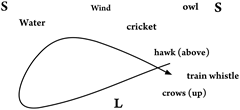
The second scene builds another environment, that of a kitchen. The sounds here are a clock, a cup, a teaspoon, a door, eggs being beaten, footsteps and a window. The clock begins the scene on the right and lasts for the scene’s entire duration. Briefly after the clock begins ticking, the cup and teaspoon are heard in front of the listener. A door slams somewhat to the right, a toaster shuts straight ahead and a person is heard eating 60 cm directly in front of the listener. The only mobile sound here is that of footsteps, walking slowly from right to left on a wooden floor. A window slams shut and finishes the scene.
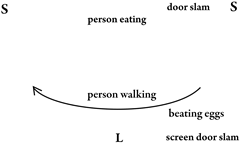
The third subsection presents the sound of electrical arcing tracing an X-shaped movement, traversing from left to right and back again to form a virtual wall in front of the listener.
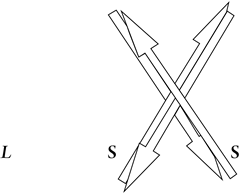
The fourth subsection consists of two air masses in front of the listener, differing in patterns of dynamics, total volume and duration. Gwiazda describes the first air mass as “a huge sphere of wind (14 ft. by 8 ft.) giving the air in front the illusion of mass” and the second as “a very quiet sound that can be seen or felt looping in front better than it can be heard” (Gwiazda 1995). The second air mass crossfades skillfully into the next subsection, the concluding third holophonic scene.
The concluding scene in the first section is a reprise of the first holophonic scene, with many of the same sound elements. Unique to this scene, a breathing sound stresses the presence of a person. Additionally, the sound of water comes in from the right; this will be repeated in the sections to come.
Section 2
The second section and emphasizes musical sounds. In contrast to the natural noises of the previous section, the sonic atmosphere here is dominated by guitar tones, human voices, church bells and a tambourine, among others, and, due to its spatial character, is experienced as closer and more tangible. Natural noises, including thunder, water, a rooster and an elephant, are present and form a dense background to the guitar, though they do not substantially affect the character of the section. The guitar is played by Gwiazda himself in an improvisatory style. Gwiazda often performs live by accompanying his sampled sounds with improvisations on electric guitar. Here, however, the guitar tones are composed and recorded and, despite their improvisatory character, fit seamlessly into the rest of the piece. An exemplary moment occurs at 2:55, in which a guitar tone is so skillfully processed as pickup notes for the voice of the auctioneer that it seems as if they originate from the same source.
The contrapuntal character here further differentiates this section from the first. Both the parallel and the fast, sequential sound events stand in contrast to the stable and harmonious texture of the first section:
[T]he music here is contrapuntal and abstract, juxtaposing sounds without creating a realistic setting. Connections between sounds are not based primarily on their literal reference (i.e. bird sounds) but on their inner pitch and rhythmic characteristics. (Ibid.)
A broken chord marks the beginning of this section and immediately combines with the guitar tones. Two overlapping sound choreographies can be differentiated. The first opens the section and lasts until 3:21, and the second begins with the water at 3:16 and continues to the end. These sound choreographies do not form holophonic scenes as in the first section, but rather are successions of sound events forming musical episodes in a varying space-time continuum.
The first sound choreography in the second section consists of an auctioneer, moving between loudspeakers from right to left and back again; the guitar, which follows the same path but in front of the listener; electrical arcing, tracing a counterclockwise circle; a paper cutter, which outlines two arcs above and below the loudspeakers; and two static sounds: a steel pillar and church bell, both of which are placed to the right of the listener.
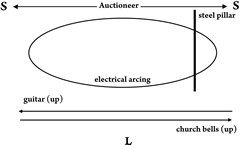
The second sound choreography consists of water, which flows from the centre down to the right; the guitar moving from right to left; a tambourine, which rotates counterclockwise; footsteps, which begin to the right and move diagonally to the distant centre; and a bird, a train whistle, thunder, a rooster, a harmonica, and more, which are scattered to the sides. A singing voice, positioned in front of the listener, ends the section.
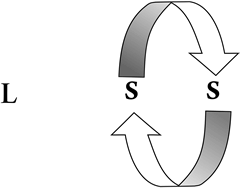
Section 3
Gwiazda considers the third section a transition connecting the second and fourth sections. It begins with a blazing inferno, wind and rains between the loudspeakers. The haptic quality of sound is particularly prominent here, with a tremendous spatial immersion created by the expansion of the sound on both the azimuth and median levels. After approximately ten seconds, the music returns to the established nature scene of the first section, in which water, breathing and birds play leading roles. The most remarkable choreography here is the meeting of a fly moving from the left, erratically at first and then calmly, and a fluttering bird from the right. This movement pattern is reminiscent of the first section, in which a stream of water flows from the right side of the listener to the left (2:40–2:43). Here the movement of the water is treated as a motive, whereby the spatial character of the water is combined with the sounds of the fly and the bird. A musical episode builds with a crescendo while moving from left to right to end the section.
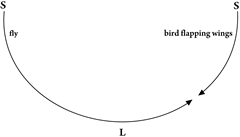
Section 4
The choreography in the shortest section of the work is characterized by a quick succession and layering of sounds, including musical quotations and very quiet tones, that work together evenly. One is reminded of the sound of the nightingale in the introduction as an air mass moves in a figure eight just before an ascending scale serves as a bridge to the fifth section.
Section 5
The fifth section opens with the sounds of a natural landscape, familiar from the first section: a cricket (from left to right), water (left), train whistle (left), and birds and insects (right, above). The scene in the first section is supplemented by new elements such as the barking of a dog (front and right) and the gallop of a horse (from left to right). Instruments already featured in the second section, such as tambourine (front) and church bell (left), and new instruments, like triangles (in front or left) and synthesized sounds (6:57, 7:07, 7:11), contribute to give the section a contrapuntal and dense texture. Of the whole piece, this section contains the most interesting choreographies. Gwiazda even designates it the climatic section precisely in reference to these choreographies (Ibid.). Apart from simple patterns like lateral movements between the loudspeakers from left to right and in reverse, the pointed movement of the basketball (7:43) or the linear movement of the horse gallop (6:29), there are spectacular choreographies in the last 34 seconds of the section. Two water streams, flowing into the centre in front of the listener from the left and right side (7:45 and 7:48), start this last phase. This movement is reminiscent of the water stream (2:40) in the first section, and of the joining of the fly and the bird from the third section (4:58–5:04). After this a window opens and the listener is apparently soaked by the water (7:52). A cymbal floats overhead in a figure eight (like the nightingale in the Introduction and the air mass in the previous section). The sound of electrical arcing, heard in the first section (1:35), rotates and moves clockwise while two trees fall to the ground on the right and left to close the section.
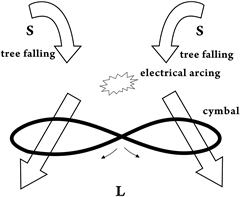
Section 6
The sixth section is divisible into three subsections. The first subsection begins with the noise of a runner (8:19–8:34), moving from the front right past the listener and fading to the distant left. This is followed by a bicycle moving behind the listener to the right. The Doppler effect is used here to simulate the approach and distancing of the bicycle. The second subsection returns again to the nature scene of the first section, though here the scene is subjected to a process of rotation. It is not the individual components of the scene that are rotated, but rather the whole scene rotates 360 degrees clockwise, in unison, around the listener. Although this simulation is successful, the entrance of an airplane (8:43) during the process disturbs the listener’s ability to follow the rotation correctly. Synthetic tones to the right begin the third subsection (9:00), followed by four percussion sounds (right, front, right, front) and applause (9:03) in front of the listener. A gust of wind, very calmly moving from loudspeaker to loudspeaker, ends the section. This movement is recognizable as referring back to the Introduction (nightingale, 0:03) and the fourth and fifth sections (air mass and cymbal at 5:57 and 8:04, respectively).
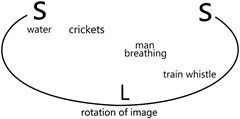
Henry Gwiazda creates a narrative, virtual sound world through the use of a unique musical language combined with instrumental virtuosity, various sonic materials and sampling. One of the most important functions of this world is to draw the listener into a pluralistic sonic environment where the objectivity of abstract structures and musical syntax is converted into realistic subjectivity. The overlap between the virtual and real worlds is achieved through the synæsthetic capabilities of our sensory systems. buzzingreynold’sdreamland is not only technically successful in its use of sampling, but also stands out among other acousmatic works because of its innovation in spatialization, both as a work of art and as an experiment. Although the lack of advanced audio processing techniques at the time of composition limits the spatial possibilities in the piece, especially on the vertical axis, this analysis shows that Gwiazda is successful in executing most of his desired spatializations.
Bibliography
Buckley, Daniel. “Henry Gwiazda.” Stereophile (1997).
Gann, Kyle. “Crunch and Counterpoint.” The Village Voice 36/8 (19 February 1991), p. 95.
_____. “The Choreography of Noise.” The Village Voice 40/45 (7 November 1995), p. 64.
Gehring, Bo. “Interactive Entertainment With Three Dimensional Sound.” 1992. Presented at the 134th Smpte Technical Conference (November 1992).
Gwiazda, Henry. Unpublished paper. 1995.
_____. “Speaker Placement Instructions.” On noTnoTesnoTrhyThms. American Composers Forum, Minnesota. 1996.
Wierzbicki, James. “Gwiazda Evokes Concrete Images of the Real World.” St. Louis Post Dispatch. Tuesday, 3 November 1992.
Social top